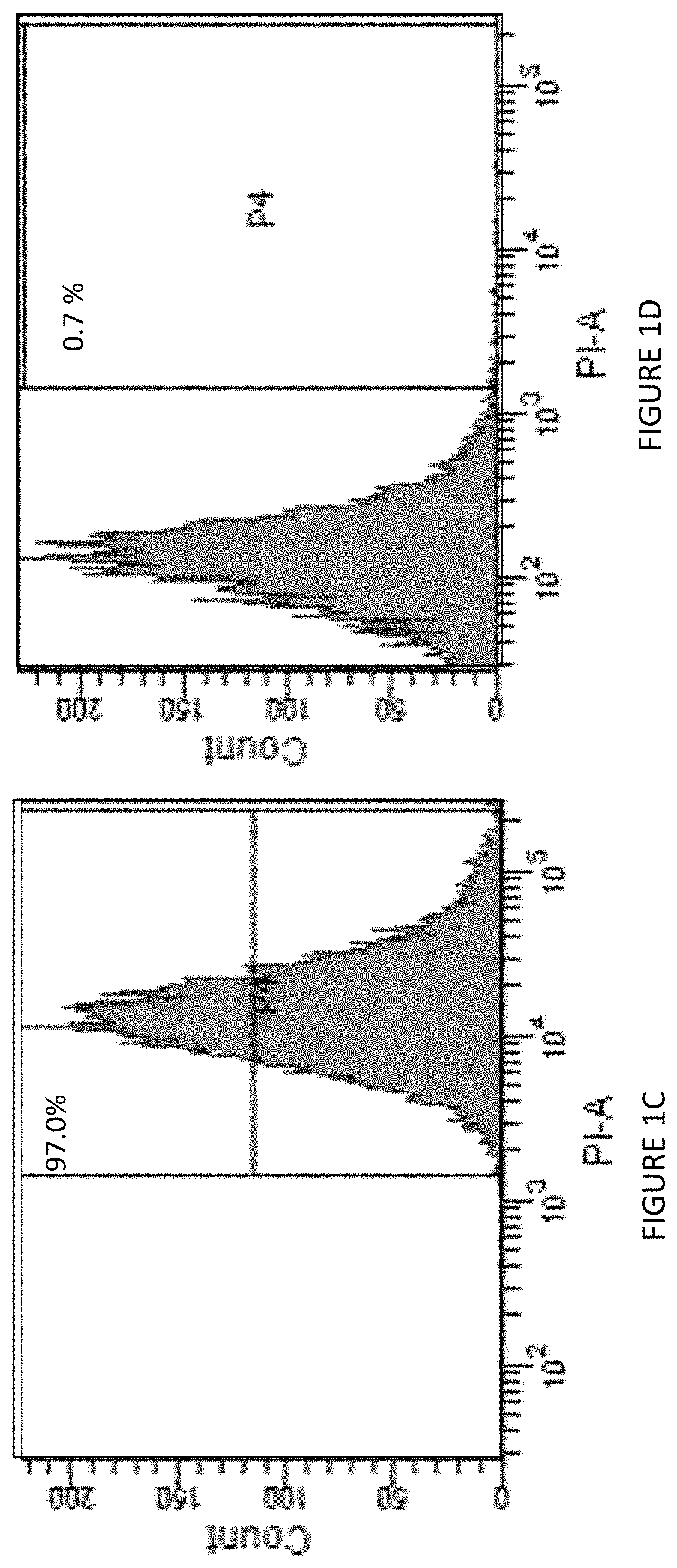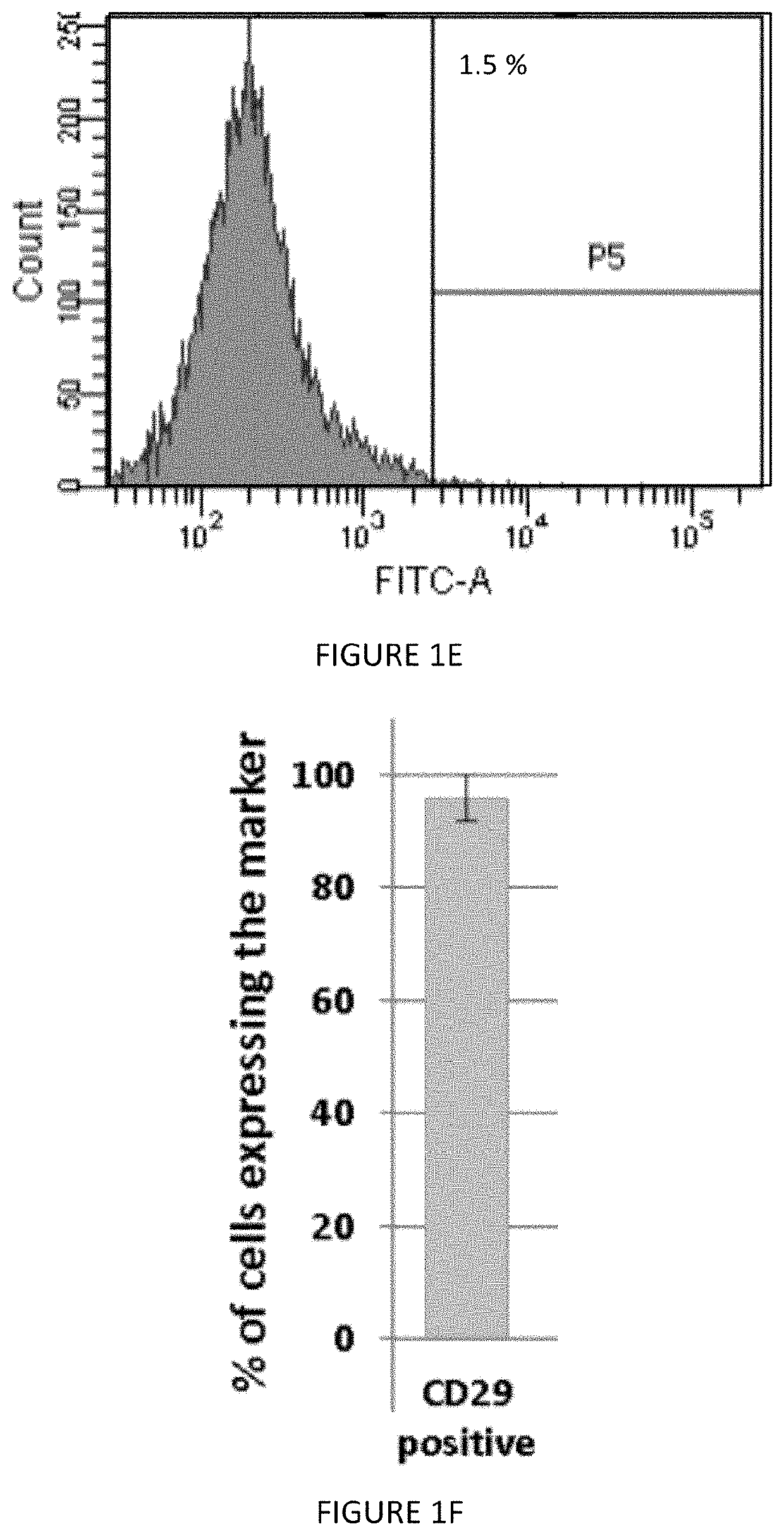Compositions and methods for treating age-related macular degeneration
a technology of macular degeneration and composition, applied in the field of regenerative medicine, can solve the problems of preventing the progression of the disease, severe and rapid loss of vision, and unable to reverse the damage to the macula, so as to prevent the degeneration of rpe
- Summary
- Abstract
- Description
- Claims
- Application Information
AI Technical Summary
Benefits of technology
Problems solved by technology
Method used
Image
Examples
example 1
Phenotypic Characterization and Multipotency of ASCs
[0139]ASCs were isolated from lipoaspirate of subcutaneous fat of donors. Phenotypic characterization was studied at passage 3 using immunostaining and FACS analysis. ASCs expressed classic MSCs markers (CD90: 100±1.98%; CD73: 97±5.2%; CD105: 97.8±1.7%; CD29: 96.0±4.0% of the population), and were negative for hematopoietic markers (CD45:1.5±0.9%; CD34:0.7±0.6%) (FIGS. 1A-1F). ASCs exhibited multipotency evident by their ability to differentiate into osteocytes and adipocytes (FIGS. 1G-1J).
example 2
Enhanced Migration of ASCs Following Exposure to Stressed RPE
[0140]Migration of ASCs exposed to conditioned medium of RPE under oxidative stress, was assessed. RPE were exposed to H2O2 as described above. As shown in FIGS. 2A-2G, the migration capacity was significantly enhanced when ASCs were exposed to conditioned medium of RPE treated with H2O2 (stressed RPE-CM) as opposed to exposure to conditioned medium of RPE not treated with H2O2 (RPE-CM) or exposure to non-conditioned medium (non-CM) (4.4±0.36-fold).
[0141]Under the same conditions, the expression of SDF-1 in stressed RPE cells was increased significantly when compared to the expression of SDF-1 in RPE without H2O2 treatment (2.4±0.086-fold; FIG. 2H). Accordingly, exposure of ASCs to the conditioned medium of stressed RPE resulted in increased expression of the SDF-1 receptor, CXCR4 (12.6±4.5-fold; FIG. 2I).
example 3
ASCs Rescue RPE From Necrosis Under Oxidative Stress In Vitro
[0142]Next, the inventors assessed the protective role of ASCs' conditioned medium on RPE cells exposed to H2O2. RPE cells were pre-incubated for 48 h with either ASCs' conditioned medium at passage 3 (P3-CM), ASCs' conditioned medium at passage 5 (P5-CM) or non-conditioned ADSC serum free medium (non-CM), followed by H2O2 (1 mM, 7 h) treatment. RPE cells exposed to P3-CM prior to H2O2 treatment exhibited a decrease in cell death evident by FACS analysis for propidium iodide (50.6±1.6% cell death reduction) while P5-CM as well as non-CM had no effect on cell viability (FIG. 3A-3E). Furthermore, stressed RPE rescued by P3-CM were also detected by Ethidium bromide and Acridine orange staining assay (51.5% cell death reduction from total cell death counted in RPE cells exposed to H2O2 only; FIGS. 3F-3G).
PUM
| Property | Measurement | Unit |
|---|---|---|
| porosity | aaaaa | aaaaa |
| porosity | aaaaa | aaaaa |
| porosity | aaaaa | aaaaa |
Abstract
Description
Claims
Application Information
 Login to View More
Login to View More - R&D
- Intellectual Property
- Life Sciences
- Materials
- Tech Scout
- Unparalleled Data Quality
- Higher Quality Content
- 60% Fewer Hallucinations
Browse by: Latest US Patents, China's latest patents, Technical Efficacy Thesaurus, Application Domain, Technology Topic, Popular Technical Reports.
© 2025 PatSnap. All rights reserved.Legal|Privacy policy|Modern Slavery Act Transparency Statement|Sitemap|About US| Contact US: help@patsnap.com



